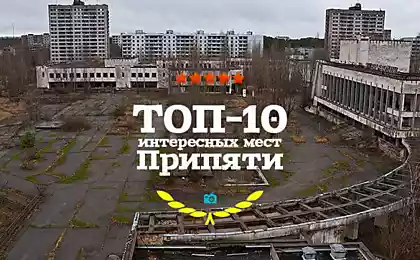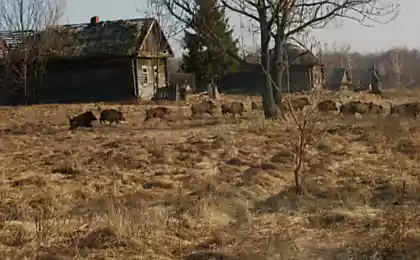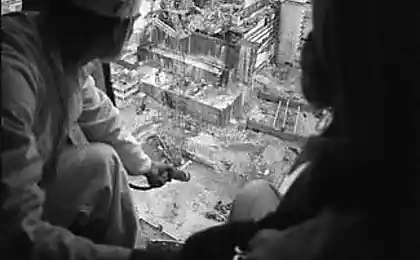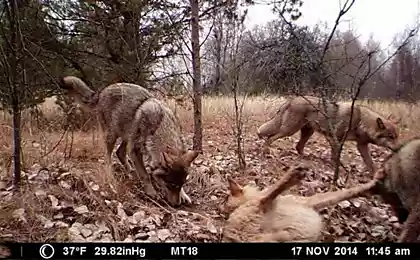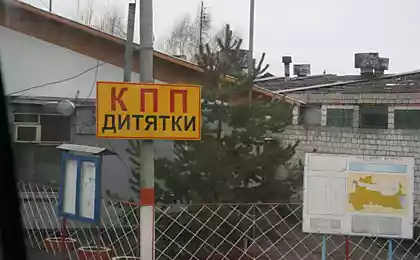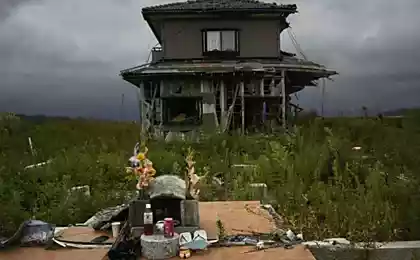2403
The fauna of the Chernobyl exclusion zone (37 photos)
Exclusion Zone - a huge forest area is almost entirely that hides from the eyes of the inexperienced tourists a lot of mysteries and unexplained mysteries. Traveling on it very rarely get the chance to meet with local animals, and even more so to capture it. The author of this photo essay went to the exclusion zone and did for you exclusive pictures of the animal world, which despite the monstrous effects of radiation could at least partially, but recuperate. In recent years, repeatedly heard, they say, the beast in the area has decreased. Ostensibly, it is not seen as often as once. But is it? .. I think I agree. Sometimes, for a day trip because no one in the eye and did not fall. But the problem is not the fall of the number of animals, and - in reducing our ability to see it. It became more difficult to observe it.
Chernobyl zone from year to year becomes more and more forest, scrub yesterday - today is a young forest stands. Roads plunged into "tunnels", turned into a grove meadows and woodlands. Many people underestimate it clearly, but we have in fact the eye - not X-rays.
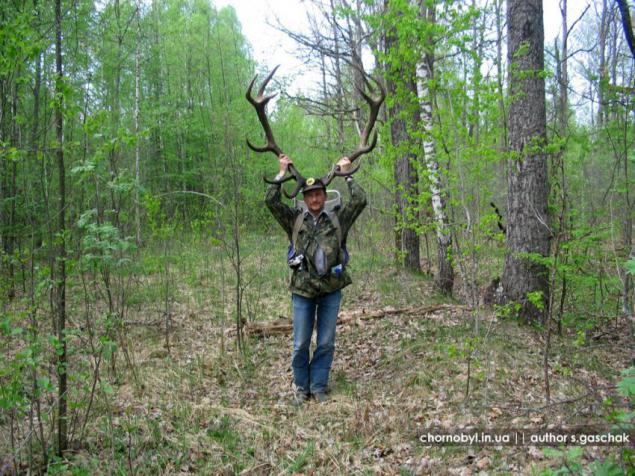
Moreover, now that 10-15 years ago, the beast was not behind every bush. Here - no park "Serengeti", there - pretty in her modesty south taiga zone. There is as much as can be. No animal is not "pressure", but nobody throws. Our brain always had the ability to "filter", a small monotonous and does not linger in the memory, and the unusual and bright - on the contrary. Because it seems that used to be "bigger and better».
In general, there are no grounds for concern. Livestock in the area a lot, and some species became clearly more. And these beliefs are entirely supported by the results of automatic shooting. Let me remind you, in order to describe the animal world of individual sections of the Chernobyl zone, we have resorted to the use of modern cameras, camera traps. Hanging on the tree itself a "device", the size of a palm, and regularly captures everyone who passes by it, be it day or night. The experience of the first year was unexpectedly successful. Forests, visiting allegedly "desert", in fact, were full of life. Ungulates and predators, creatures large and small, four-legged and feathered - impartially all the cameras were filming. Many of the pictures are not just come out beautiful, but also very eloquently talked about the secrets of wildlife.
In June 2013 it was decided to transfer the equipment to a new site. In order to keep the "secrecy of the investigation," I can only say that it is - a very savage land, although they are not so far from the "epicenter" of human activity. In many respects, there - a real sanctuary. For more complete coverage of habitats we placed the camera in the depths of the forest and on the edge and on the meadow. The idea was not only to identify the species composition of animals, but also to describe what changes are taking place throughout the seasons in each of the habitats. Before the finish line is still far, but the cameras have otschelkali tens of thousands of staff, and we have something to boast!
Most "downhole" frames again linked with lynx. It is noted in all five points scattered over an area of 25 km2, and there are not at least two adult females with lovely kittens and at least two adult males. It - where a higher density than we expected. Equally impressed by the fact that the lynx, contrary to my understanding, it is active in the daytime, and did not hesitate to presence of "foreign object". It - adorable animal decoration of our region!

The female lynx with kitten on forest watering

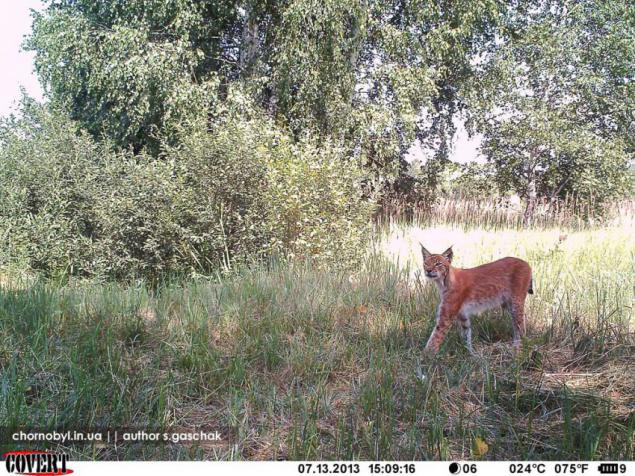
The male lynx in the hunting grounds crawling

Other great pictures are dedicated to the family of cranes. Another "Red Book" in our piggy bank values. It so happened that I met them earlier, at the beginning of June, when the chick has been quite small. What was surprising that they still made it to one of the cameras (there are about a kilometer), then came back a month later, and, moreover, have arranged for the camera very real "photo shoot" with dancing! Super!

Another protected, but quite common in the area of animal - is the otter. Unexpectedly one camera installed right next to her plot. And if I were a river otter (scientific name), then there would never have lived, but she turned out to be more visible. The camera recorded the agile animal, and day and night. How many are there, it's hard to say otters - sociable animals, but in the frame has always been only one individual.
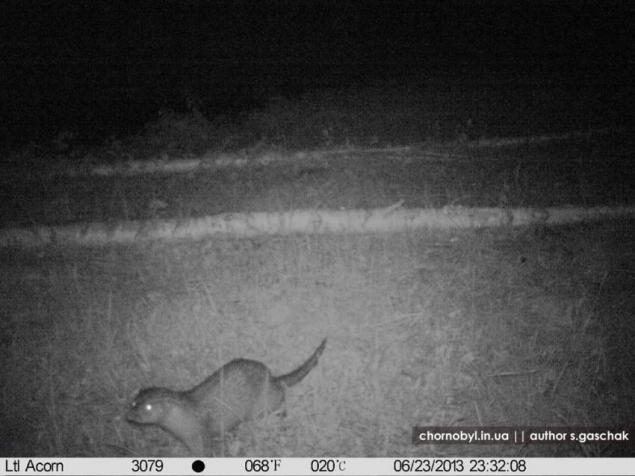
Two rare species - a black stork and the eagle. Photos of both puzzling question. Stork was "bearded": caught in the beam frame with some vegetation in its beak. Perhaps the bird was engaged in the construction or repair of the nest. However, the court had on June 16! At this time, not to the "housing problem", sitting in the nest large and demanding offspring. However, not a hindrance, perhaps my father decided to teach a lesson gnezdostroeniya.
What about the spotted eagle (probably small), it is several times over three months down in the same place in the middle of the forest, on the site where the trees do not even have clearance, and wandering back and forth there. Why - a mystery. Although a number and a pool, but it it did not show the slightest interest.

(Small) Spotted Eagle
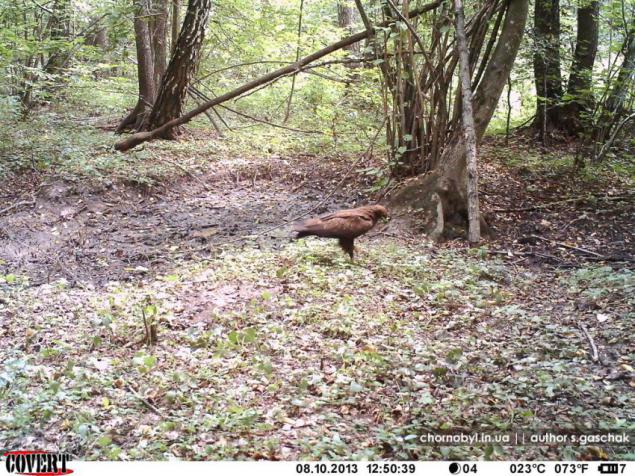
The rest of the trophies were much more common. Raccoon dogs - the undisputed leader of photography. A large proportion of staff contained elk and deer, markedly less - deer. Boars for a long time, and if there were, it was a single bill hooks or small groups of men, and only in late summer, early autumn mother showed up the herd, full of pig's dynamics. There were also other animals: badger, marten, mink, hare, hare, beaver, bittern, blackbirds, tits, Shrike, mallard, owl and insects. Male deer

Wild boar in the mud bath
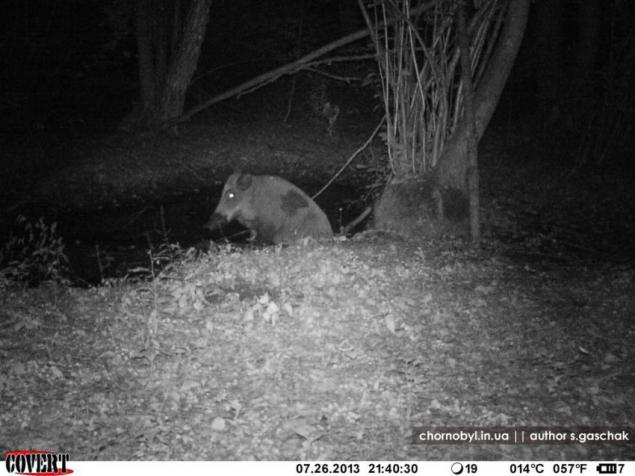
Elk at watering

Raccoon dog - the most common objects in the frame
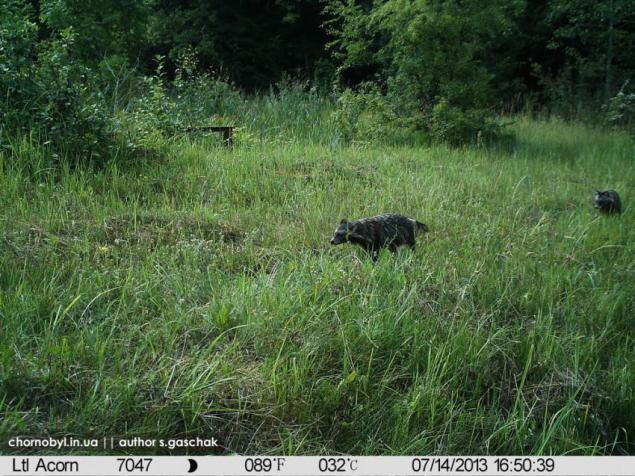
Deer
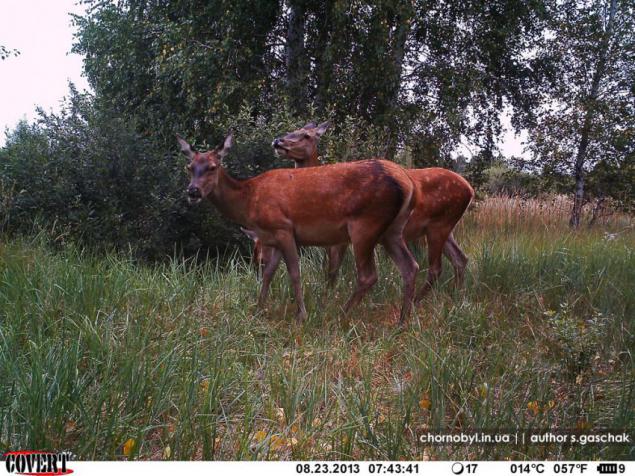
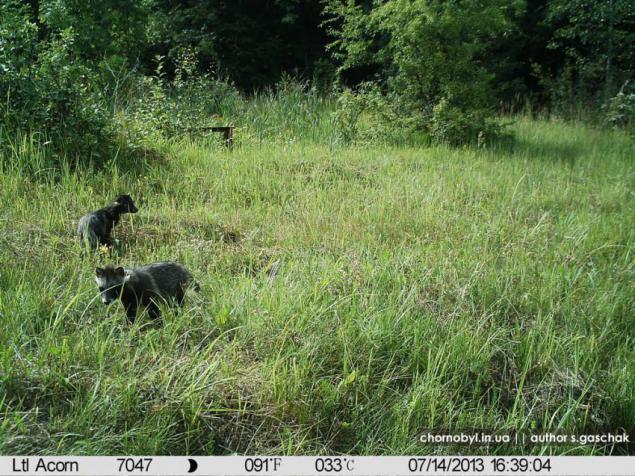
The growth of offspring - is perhaps one of the most remarkable features of the summer photography. Weak, touching and vulnerable creation gradually gain strength, and if the care of parents and good luck did not pass them by, turning into impudent and not so attractive teenagers. This summer, the rapid growth of "other people's children" happened to mention many of the inhabitants (lynx, cranes, wild boar, elk, deer, raccoons).





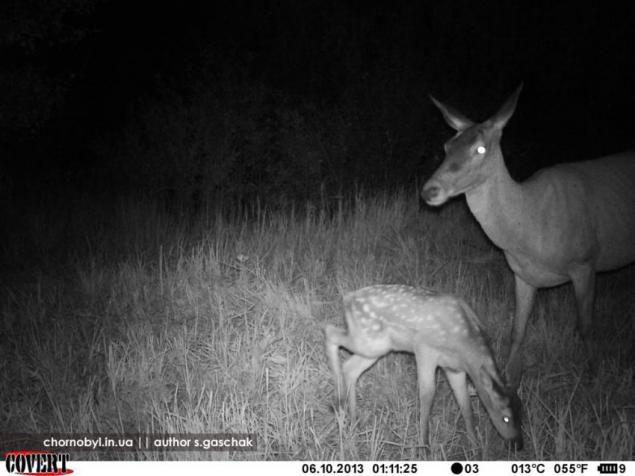

Unfortunately, not everyone had a chance to grow. Back in May, we found a calf suckling, the victim is likely to hunger: that it be thrown careless mother, whether she had previously lost. At least one reason for that is always there. Chernobyl zone - is a land of wolves. They are always there, they often fall into the field of view. Once she took elements of night hunting, when a difference of half a minute past the camera ran moose and wolf. The two wolves ran stories, along with the loot. Alas, in one case, it was a calf's head. It always has been and always will, it is - only one side of a multi-faceted life of wildlife. Wolf-headed calf
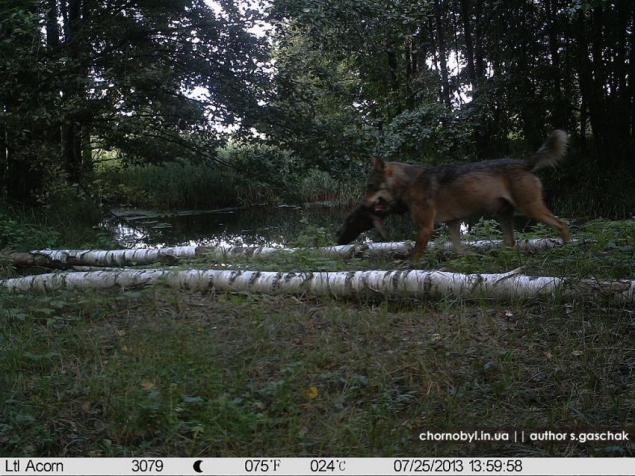
Wolf with a deer leg

Especially pleased to find that many kids grow up and not much inferior roditelyam.Mezhdu those wolves life is also full of drama. They are opposed centners ostrorogoy and saber-toothed production of motion or shock is enough to knock the heart out of any gray predator. Yes, and they get along with each other, but yet recognize the existing hierarchy. Any attempt by an order rigidly suppressed, can not remain only without the family and territory, but also pay for health and life. In one series of shots, we found the one-eyed wolf, he confidently ran the first in the pack. How it happened we do not know, but it is clear that a full stomach - does not guarantee the sweetness of life. The one-eyed wolf runs in the first pack

A family of wolves in the night hunting

Photography allowed to identify and change the territorial behavior of animals. In the first half of the summer ungulates obviously kept relatively small areas. First, near the chamber regularly appeared the same individual, and, secondly, if so, this place turned out to be rich or poor in the animals, it is confirmed every day. But by the end of summer activity increased, from somewhere appear more and more new animals. Sometimes this can not but cause surprise, because When you visit the same areas but trails rare that you see more. What came to the forest boar's pretty obvious they are in oak poperevorachivali everything you can: looking for acorns. But the reason for the activity horned ungulates, apparently, was the preparation for the marriage battles. Horn of deer and elk - one of the most amazing creations of nature, which can be considered, either by killing its owner, or by placing camera traps. Honestly, I never thought about how much they vary even within the same species. And how are huge! To wear a neck decoration need not weak! I remember one day, to take a photo with dumped deer horns, I had a very tense for only a few seconds of posing.






Taking pictures with automatic cameras and presented some surprises. One of them is hardly pleasant, but it reflects the reality of Chernobyl lives. As if the land was not deaf and wild, but the man gets around, and not always with good intentions. At one point, the camera shot poacher. Surprisingly, he did not notice her!

Another discovery I made, and strained every time a very cautious approach to the installation site. For some reason, the camera turned out to be the focus of hornets. Unfortunately, the experience with them I already had, and repeat it as something not desirable. A hornets, judging by the pictures, often and long crawling on the camera, causing a "gate" and scoring card. Whether it's a film camera, I would be broke! .. Some pictures out of the general mass, they represent unexpected symptoms in animal behavior. Sometimes - curious, and sometimes - just funny. So, the least one could imagine that the wild boars, if necessary, then climb a tree! .. I never thought that among the variety fotogeroev most incredulous to the camera are only moose, deer and roe deer: they study it for a long time, or even a sniff trying to lick, and sometimes rush to their heels. Badger reason considers it necessary to make his mark exactly at the point where I dropwise pack of salt, but even more fun - that wild boars there often fall out and rub! Well, a series of pictures of losya- "exhibitionist" in addition to hysterical laughter and the rhetorical question is: well, why in front of the camera and so hard? Kaban climbs a tree, smell the remains fixed there fell



In general, the summer season was successful. It received a lot of informative material, the selected area was very rich, both in animals and in the interesting findings. Some shots were so successful, that would please and experienced photographer.
In the photo: "So I better get!»
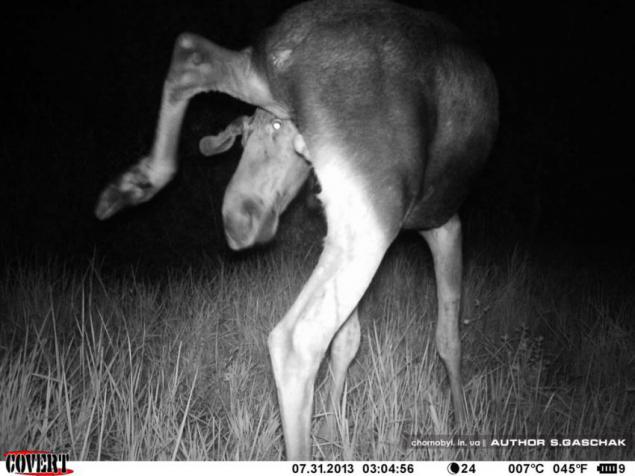
Source: chornobyl.in.ua
Chernobyl zone from year to year becomes more and more forest, scrub yesterday - today is a young forest stands. Roads plunged into "tunnels", turned into a grove meadows and woodlands. Many people underestimate it clearly, but we have in fact the eye - not X-rays.

Moreover, now that 10-15 years ago, the beast was not behind every bush. Here - no park "Serengeti", there - pretty in her modesty south taiga zone. There is as much as can be. No animal is not "pressure", but nobody throws. Our brain always had the ability to "filter", a small monotonous and does not linger in the memory, and the unusual and bright - on the contrary. Because it seems that used to be "bigger and better».
In general, there are no grounds for concern. Livestock in the area a lot, and some species became clearly more. And these beliefs are entirely supported by the results of automatic shooting. Let me remind you, in order to describe the animal world of individual sections of the Chernobyl zone, we have resorted to the use of modern cameras, camera traps. Hanging on the tree itself a "device", the size of a palm, and regularly captures everyone who passes by it, be it day or night. The experience of the first year was unexpectedly successful. Forests, visiting allegedly "desert", in fact, were full of life. Ungulates and predators, creatures large and small, four-legged and feathered - impartially all the cameras were filming. Many of the pictures are not just come out beautiful, but also very eloquently talked about the secrets of wildlife.
In June 2013 it was decided to transfer the equipment to a new site. In order to keep the "secrecy of the investigation," I can only say that it is - a very savage land, although they are not so far from the "epicenter" of human activity. In many respects, there - a real sanctuary. For more complete coverage of habitats we placed the camera in the depths of the forest and on the edge and on the meadow. The idea was not only to identify the species composition of animals, but also to describe what changes are taking place throughout the seasons in each of the habitats. Before the finish line is still far, but the cameras have otschelkali tens of thousands of staff, and we have something to boast!
Most "downhole" frames again linked with lynx. It is noted in all five points scattered over an area of 25 km2, and there are not at least two adult females with lovely kittens and at least two adult males. It - where a higher density than we expected. Equally impressed by the fact that the lynx, contrary to my understanding, it is active in the daytime, and did not hesitate to presence of "foreign object". It - adorable animal decoration of our region!

The female lynx with kitten on forest watering


The male lynx in the hunting grounds crawling

Other great pictures are dedicated to the family of cranes. Another "Red Book" in our piggy bank values. It so happened that I met them earlier, at the beginning of June, when the chick has been quite small. What was surprising that they still made it to one of the cameras (there are about a kilometer), then came back a month later, and, moreover, have arranged for the camera very real "photo shoot" with dancing! Super!

Another protected, but quite common in the area of animal - is the otter. Unexpectedly one camera installed right next to her plot. And if I were a river otter (scientific name), then there would never have lived, but she turned out to be more visible. The camera recorded the agile animal, and day and night. How many are there, it's hard to say otters - sociable animals, but in the frame has always been only one individual.

Two rare species - a black stork and the eagle. Photos of both puzzling question. Stork was "bearded": caught in the beam frame with some vegetation in its beak. Perhaps the bird was engaged in the construction or repair of the nest. However, the court had on June 16! At this time, not to the "housing problem", sitting in the nest large and demanding offspring. However, not a hindrance, perhaps my father decided to teach a lesson gnezdostroeniya.
What about the spotted eagle (probably small), it is several times over three months down in the same place in the middle of the forest, on the site where the trees do not even have clearance, and wandering back and forth there. Why - a mystery. Although a number and a pool, but it it did not show the slightest interest.

(Small) Spotted Eagle

The rest of the trophies were much more common. Raccoon dogs - the undisputed leader of photography. A large proportion of staff contained elk and deer, markedly less - deer. Boars for a long time, and if there were, it was a single bill hooks or small groups of men, and only in late summer, early autumn mother showed up the herd, full of pig's dynamics. There were also other animals: badger, marten, mink, hare, hare, beaver, bittern, blackbirds, tits, Shrike, mallard, owl and insects. Male deer

Wild boar in the mud bath

Elk at watering

Raccoon dog - the most common objects in the frame

Deer


The growth of offspring - is perhaps one of the most remarkable features of the summer photography. Weak, touching and vulnerable creation gradually gain strength, and if the care of parents and good luck did not pass them by, turning into impudent and not so attractive teenagers. This summer, the rapid growth of "other people's children" happened to mention many of the inhabitants (lynx, cranes, wild boar, elk, deer, raccoons).







Unfortunately, not everyone had a chance to grow. Back in May, we found a calf suckling, the victim is likely to hunger: that it be thrown careless mother, whether she had previously lost. At least one reason for that is always there. Chernobyl zone - is a land of wolves. They are always there, they often fall into the field of view. Once she took elements of night hunting, when a difference of half a minute past the camera ran moose and wolf. The two wolves ran stories, along with the loot. Alas, in one case, it was a calf's head. It always has been and always will, it is - only one side of a multi-faceted life of wildlife. Wolf-headed calf

Wolf with a deer leg

Especially pleased to find that many kids grow up and not much inferior roditelyam.Mezhdu those wolves life is also full of drama. They are opposed centners ostrorogoy and saber-toothed production of motion or shock is enough to knock the heart out of any gray predator. Yes, and they get along with each other, but yet recognize the existing hierarchy. Any attempt by an order rigidly suppressed, can not remain only without the family and territory, but also pay for health and life. In one series of shots, we found the one-eyed wolf, he confidently ran the first in the pack. How it happened we do not know, but it is clear that a full stomach - does not guarantee the sweetness of life. The one-eyed wolf runs in the first pack

A family of wolves in the night hunting

Photography allowed to identify and change the territorial behavior of animals. In the first half of the summer ungulates obviously kept relatively small areas. First, near the chamber regularly appeared the same individual, and, secondly, if so, this place turned out to be rich or poor in the animals, it is confirmed every day. But by the end of summer activity increased, from somewhere appear more and more new animals. Sometimes this can not but cause surprise, because When you visit the same areas but trails rare that you see more. What came to the forest boar's pretty obvious they are in oak poperevorachivali everything you can: looking for acorns. But the reason for the activity horned ungulates, apparently, was the preparation for the marriage battles. Horn of deer and elk - one of the most amazing creations of nature, which can be considered, either by killing its owner, or by placing camera traps. Honestly, I never thought about how much they vary even within the same species. And how are huge! To wear a neck decoration need not weak! I remember one day, to take a photo with dumped deer horns, I had a very tense for only a few seconds of posing.






Taking pictures with automatic cameras and presented some surprises. One of them is hardly pleasant, but it reflects the reality of Chernobyl lives. As if the land was not deaf and wild, but the man gets around, and not always with good intentions. At one point, the camera shot poacher. Surprisingly, he did not notice her!

Another discovery I made, and strained every time a very cautious approach to the installation site. For some reason, the camera turned out to be the focus of hornets. Unfortunately, the experience with them I already had, and repeat it as something not desirable. A hornets, judging by the pictures, often and long crawling on the camera, causing a "gate" and scoring card. Whether it's a film camera, I would be broke! .. Some pictures out of the general mass, they represent unexpected symptoms in animal behavior. Sometimes - curious, and sometimes - just funny. So, the least one could imagine that the wild boars, if necessary, then climb a tree! .. I never thought that among the variety fotogeroev most incredulous to the camera are only moose, deer and roe deer: they study it for a long time, or even a sniff trying to lick, and sometimes rush to their heels. Badger reason considers it necessary to make his mark exactly at the point where I dropwise pack of salt, but even more fun - that wild boars there often fall out and rub! Well, a series of pictures of losya- "exhibitionist" in addition to hysterical laughter and the rhetorical question is: well, why in front of the camera and so hard? Kaban climbs a tree, smell the remains fixed there fell



In general, the summer season was successful. It received a lot of informative material, the selected area was very rich, both in animals and in the interesting findings. Some shots were so successful, that would please and experienced photographer.
In the photo: "So I better get!»

Source: chornobyl.in.ua







